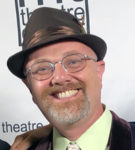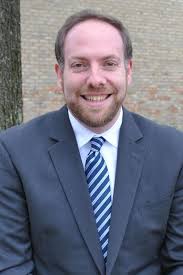

CINCINNATI, Ohio — I sat down with Rabbi Michael Danziger of the Plum Street Temple (aka B’nai Yeshurun and the Isaac M Wise Temple). The cornerstone was laid in 1865. With only two hundred families at the time, they built a house of prayer that can seat 1,100 directly across from City Hall.
Unfortunately, I was not able to go inside and see what I am told is a beautifully restored interior. Because of an attempted break-in, a lock was added to which Rabbi Danziger did not yet have a key. Undaunted, we found a bench in nearby Garfield Park for our conversation.
Q: Tell me what you were saying about the Plum Street Temple being in the center of things.
Rabbi Michael Danziger: The congregation and Rabbi Wise saw this as the place to be for those who really wished to fully participate in Cincinnati community. … We were not just going to be a small immigrant group of others, but fully embrace our rights.
Q: And how would you describe the environment of Cincinnati to be Jewish?
RMD: Now or back then?
Q: Back then and now.
RMD: There are others who could speak more cogently and with greater historical knowledge. There was first of all a great deal of division between … the German population and the Eastern European population. They lived in different parts of the city and went to different synagogues. … As much as we think about Jews trying to fit in, there was also the question of how they meshed with each other.
Cincinnati has today a vibrant Jewish community, not major in size [20,000-30,000]. But the presence of Hebrew Union College can’t be ignored. … Jewish kids who grow up here are often taught by future rabbis. That’s not the case for kids everywhere.
Q: One of the things that I learned from the History of Cincinnati Museum was that the new Jewish immigrants from Germany just didn’t mesh with the established Jewish community. That’s why they imported Rabbi Wise. What were some of the issues that divided them?
RMD: The congregation [of B’nai Yeshurun] had actually been established for twenty years when they brought Isaac Wise. … And Rabbi Wise had made one other stop in New York State, before coming to Cincinnati. His tenure there had fizzled out amidst reforms that he was instituting. It came to a head on Rosh Hashana [around 1850.] The President of the Congregation was in Wise’s chair on the bima, blocking him from the Ark. It got into a fistfight and [Wise] was jailed for inciting a religious mob. … He came here a few years later on the condition that his contract was for life and that he was a unanimous choice. He knew what he wanted and the congregation knew what it wanted because they said Yes.
Q: A few years ago, I was in an Orthodox synagogue. Somebody heard that I was from Cincinnati and he asked me about the infamous “Treyfa Banquet.”
[This was the banquet of 1883 celebrating the first class of rabbis from HUC serving both meat and dairy dishes as well as shrimp, crab, oysters and frogs’ legs.]
He asked what the point of that was. So I’d like to get your take on it. What was the point of that?
RMD: It’s a really good question and there are questions to this day. … I think too much is made of that as the moment it was clear there would be a Reform and a Conservative movement. …The fact that we’re still talking about this meal from 1883 is amazing.
Q: The divides among Jews back then were national, German and Russian, which I see as a Reform/Orthodox divide. Anyone from a shtetl would be more Orthodox, all Hebrew with women in the balcony. But Reform Judaism was originally called “German Judaism.” What would you say are the divides today among Jews?
RMD: Some of the same modes of practice. He was making changes such as having an organ and family seating with men and women together. Some of those things that were not palatable then and remain not palatable. Israel can be a wedge between people who feel that they need to support Israel with all of their heart and soul where others feel that supporting Israel includes criticism. That’s relevant today as Israel prepares to annex some West Bank lands. That’s a discussion to be had.
And there’s the question: Who are you responsible to? Who tells you what to do to be a good Jew? In more progressive movements, it tends to be yourself. Whereas the more traditional view has a rabbi whose rulings are binding.
Q: I want to go back to the Plum Street Temple being put in the heart of downtown because you wanted to show that Jews were full participants in this city. Can you give me one example where you’ve seen the Jewish community as part of the wider community?
RMD: An important thing about Wise himself is that he really saw [America] as the place where Judaism was going to have a Golden Age. This was the Zion that we had been waiting for. We didn’t need to get back to Israel. We had found the place where we could be fully Jewish and fully citizens, free to be ourselves and not separate.
Q: : Doesn’t that take away from Zionism? Our prayer books don’t mention Washington DC.
RMD: It definitely did early on. Reform Judaism was not Zionist in its earlier years. As the land was being repopulated and rebuilt, and by the Holocaust, there was strong support for Israel. I think [Wise] would have said [Israel] is our history and [America] can be our future.
Q: Shouldn’t we take that with a grain of salt? We were awfully comfortable in Germany too.
RMD: In our day, we might be leery of that. But I think he was too. [Wise] would vociferously fight any sort of exclusion or anti-Semitism and hold America to its ideals. “We’re citizens too. So don’t declare a Christian Day of Prayer for the death of the President.”
Q: Back then, the Jews had the only non-Christian houses of prayer. In the twenty-first century, there’s much greater religious diversity. Describe your relationship with some of the other houses of faith in the neighborhood.
RMD: We have relationships all over the city. I think there’s probably more that we could do to come to each other’s defense when needed. … But just last night, Rabbi Kamrass, our Senior Rabbi, had a Zoom program with a pastor from a nearby Black church having a frank conversation about race. …Our kids do an interfaith lock-in on MLK weekend and understand the importance of building those relationships.
Q: What do you see as some of the challenges facing the Jewish community today?
RMD: Our liberal Judaism and being responsible to yourself runs the risk of making it either a ‘Judaism of Convenience’ or a Judaism of great thoughtfulness and responsibility. One challenge is helping people understand and opt for the latter. … There’s a general societal shift away from organized religion. So we continue to ask the question: Why does this matter?
Q: So why does it matter?
RMD: I had to come up with a ten-word answer for why Judaism matters. I settled on: Judaism makes the world better and we’re not done yet.
…I think there are lots of ways that it lights the path to becoming the person that we want to be.
*
And that was the gist of my conversation with Rabbi Michael Danziger of the Plum Street Temple in downtown Cincinnati, Ohio. If you’re ever in the area, you can visit this beautiful house of prayer once the plague of COVID-19 has passed and the doors open again.
*
Eric George Tauber is a freelance writer specializing in the coverage of the arts. He may be contacted via eric.tauber@sdjewishworld.com